Haiti’s Grim History of Being “Open for Business”
The gold mines planned for Haiti’s north come on the heels of centuries of foreign investment in – and extraction of – the countries minerals and other natural and agricultural resources.
1492: Writing in his journal during his first voyage, Christopher Columbus said the people of what would later be called “Hispaniola” – today comprised of Haiti and the Dominican Republic – gave the sailors gold with “such generosity of heart and such joy that it was wonderful.” Every other entry has references like “great pieces of gold,” and “pieces of gold as large as the hand.”
In the years that followed, hundreds of thousands, some say millions, of indigenous people died in gold mines and due to Spanish-borne diseases
A decade after Columbus’ first trip, the Spanish crown was already getting its “royal fifth” (20 percent of all gold found) from the Caribbean, collecting 8,000 ducats (about 884 ounces) in 1503, and about 120,000 ducats (13,272 ounces) in 1518.
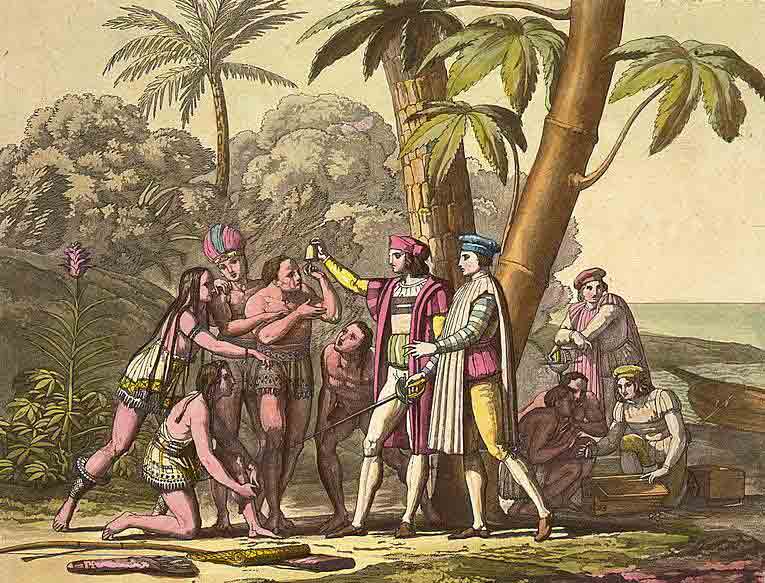
Columbus and his men often traded hawk's bells and other trinkets for chunks of gold.
1697-1804: The labor of an estimated 800,000 African slaves earned the French colony the nickname “Pearl of the Antilles” because of the massive wealth produced for the French crown and French investors exporting sugar, coffee and indigo. According to some researchers, by 1789 the colony exported one-half the world’s coffee and accounted for about 40 percent of France’s foreign trade.
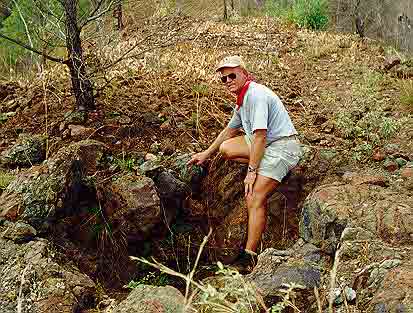
Explorer stands near a copper mineshaft dating
from the 16th century. Photo: Florida Museum of
Natural History
1857: US sea captain Peter Duncan proclaimed La Navasse Island, off Haiti’s lower “arm,” a “US territory” under the 1856 US Guano Island Act, which proclaimed that any US citizen could take “peaceable possession” of any guano-rich “island, rock or key” that is “not within the lawful jurisdiction of any other Government.” Guano – bird dung – was in high demand as a fertilizer.
La Navasse was part of Haiti, but no matter. The US claimed the island and a company town was built to “mine” the dung. Today, the company shuttered, La Navasse is still considered US territory by Washington, but it remains claimed by Haiti and listed in her 1987 Constitution.
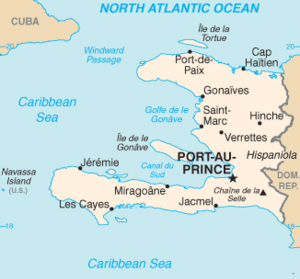
Map showing
the location of
La Navasse [far left]
(called "Navassa Island"
on US maps).
The Haitian Constitution
names it as
one of Haiti's islands.
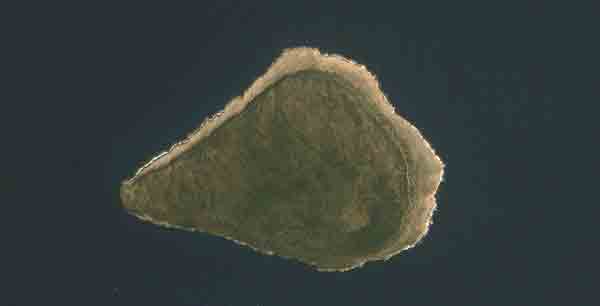
Aerial view of La Navasse, taken from outer space. The island is about two
square miles (5.2 square kilometers). Image courtesy of the Image Science
& Analysis Laboratory, NASA Johnson Space Center
1910: Hayti Mines Company, based in New York, bought Compagnie Minière de Terre-Neuve. Over ten years, the company exported 436 tons of copper ore. No more information is available.
1911: W.R. Grace backed entrepreneur James MacDonald, which allowed him to take over Haiti’s National Railroad Company. In exchange for promising to build a railway up to the northern city of Cap-Haitien, MacDonald was given 50-year concessions for all the land alongside the eventual 320-kilometer railway line for banana plantations – two kilometers in each direction – as well as a 50-year monopoly on banana exports. The MacDonald Company issued US$35 million worth of bonds which were 60 percent guaranteed by the Haitian government. MacDonald failed and fled. During the US occupation, the Haitian government was forced to pay out over $4 million to investors.
1915-1934: US occupation of Haiti. Explained President Woodrow Wilson in 1913: “Our responsibility to the American people demands that we assist American investors in Haiti.”
In 1914, US Marines seized Haiti’s gold reserves, and within months US Marines invaded to begin what would be the longest of all US occupations to date.
Over 1,000 square kilometers of land were granted to US companies between 1917 and 1927, and another 1,000 square kilometers were sold to US companies after 1928, when the puppet parliament passed a law allowing foreigners to buy land. Tens of thousands of farming families were expelled from their plots by the pineapple, sugar, banana, and sisal plantation companies. Firms included the familiar ones like United Fruit and Standard Fruit, but also new ones, like Haitian Products Co., Haitian American Co., etc. Most investments ended in failure.
This period also saw massive migration of Haitian laborers, illegally and legally, to Cuba and the Dominican Republic in search of work. Total numbers are not known but from 1915 to 1930, between 5,000 and 20,000 mostly male labors legally went to Cuba each year.
1935: Standard Fruit and Steamship Company signed a 10-year contract, which was renewed for another five years. The New Orleans-based firm was given a monopoly over all banana exports for the first ten years, and over most exports for the period 1945-1950. By 1945, in the Artibonite Valley alone, the company controlled 3,900 hectares directly and bought bananas from farmers on another 5,000 hectares. Growers who refused to plant bananas often faced repression and torched fields. Bananas became one of the country’s major exports by 1945, but the corruption of government authorities and other factors contributed to a gradual decline.
1941: Establishment of Haitian American Agricultural Development Company (SHADA in French) in order to supply the US government with rubber and sisal (for rope) for the World War II effort.
The firm got a US$5 million loan from the US Export-Import Bank and a concession of a total of about 60,000 hectares of farmland and pine forest for the dual purpose of logging and of planting or rubber and of cryptostegia, a rubber bush. In addition, SHADA got over 130,000 hectares of land in the north and northeast, which it logged completely, in order to set up sisal plantations. Farmers thrown off their land received a pittance – between $5 and $25 per carreau (1.29 hectares) – as recompense. A million fruit trees in Haiti’s southwest alone (Grande Anse) were hacked down. In just one year, 1943, over 30,000 families were expelled from their lands.
The rubber project closed down in 1945, with a $6.8 million loss. Other SHADA projects lost over $2 million that year, too. SHADA is considered on the worst fiasco “development” projects in Haitian history.
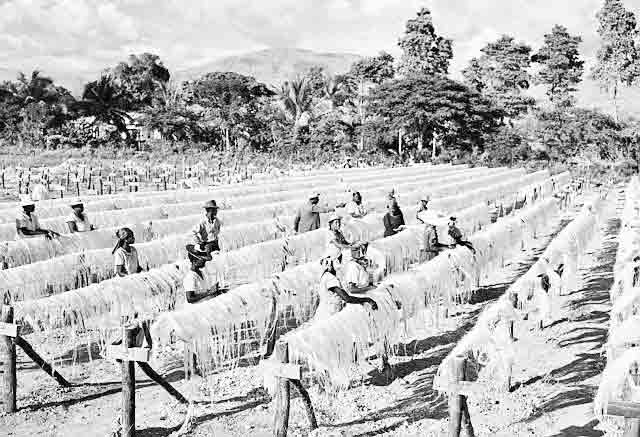
Haitian workers at a sisal plantation.
1944: Reynolds Haitian Mines, Inc., obtained an exclusive monopoly on bauxite and a concession to mine near Miragoâne. Over about 40 years, 13.3 million tons of bauxite was sent up to Corpus Christi, Texas. Haitian bauxite accounted for almost one-fifth of Reynolds’ bauxite acquisition in the years between 1959 and 1982. Reynolds was given access to 150,000 hectares. Thousands of families were expelled.
The Haitian government got royalties of 90 US cents on the metric ton at first, then US $1.29. When Haiti and other countries formed the International Bauxite Association (IBA) in 1974, royalties went up again, but within six years, Reynolds had pulled out, having extracted most of the bauxite and also in search of countries with lower royalties.
Over its four decades in Haiti, Reynolds built one eight-mile road and employed about 300 people.
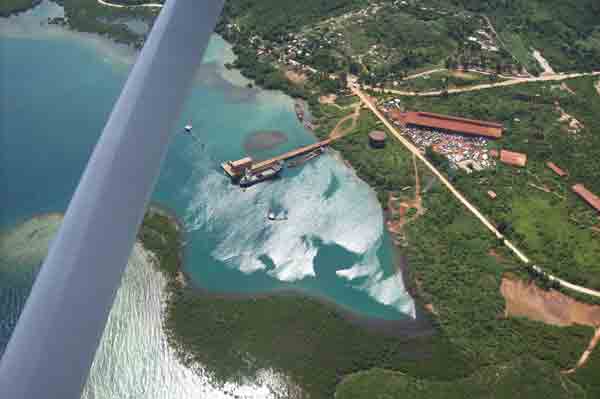
The old Reynolds plant and wharf near Miragoâne, Haiti.
1955: The Société d'Exploitation et de Développement Economique et Naturel (SEDREN), owned by the Canadian company Consolidated Halliwell, obtained a concession to mine copper in the region of Mémé (Terre-Neuve/Gonaïves). Over 12 years (1960-1972), SEDREN exported 1.5 million tons of copper ore valued at about $83.5 million. The government got about US$3 million.
At its high point – 1971 – the mining industry (Reynolds and SEDREN together) employed only 889 people, who were paid only the minimum wage – less than 70 US cents a day at the time. All skilled labor came from overseas.
What do historians say?
Haitian economist Fred Doura has called Haiti’s economy a dependent and “extraverted” characterized by enclaves. Speaking of mining, he wrote:
“The extractive industry in Haiti is a typical example of an ‘enclave’ industry under foreign domination where two North American transnationals exploited the minerals bauxite and copper… [T]he impact was practically null on the economy.” [Économie d’Haïti – dépendence, crise et développement (2001)]
Sociologist and historian Alex Dupuy agrees with Doura’s assessment.
“Historically, foreign investments have not had positive impacts on the Haitian population in general,” the Wesleyan professor explained to Haiti Grassroots Watch in a telephone interview in February 2012. “Usually a few members of the Haitian elite benefit, the state takes its part, and then the profits all go to the company.”
“Peasants have good reason to be distrustful of any and all proposals of foreign investment in Haiti, because they know very well how these projects have gone in the past,” added the professor, author of Haiti in the World Economy – Class, Race and Underdevelopment (year). “They are here to invest for themselves, not for the country, not for the peasants. They appropriate peasants’ lands, taking away their only means of livelihood. So why should peasants trust them, or the central government in Port-au-Prince, or anyone else?”
Return to the series Introduction
Return to the first story in the series Gold Rush in Haiti!

